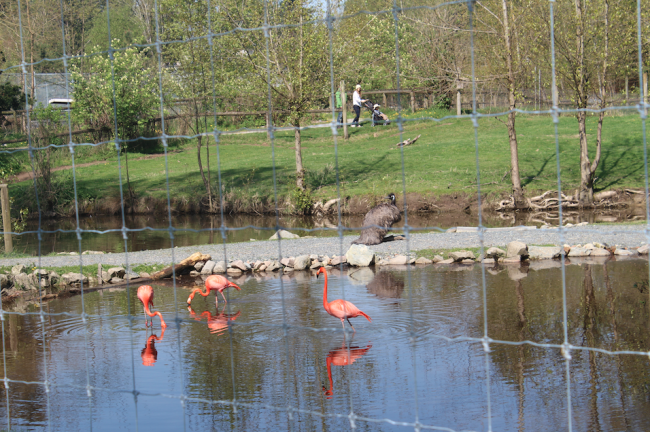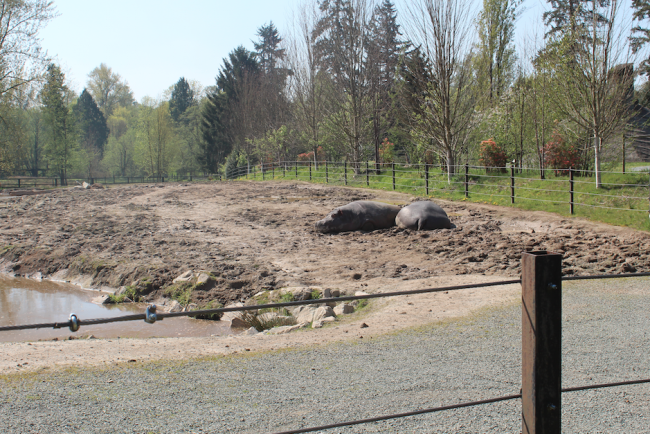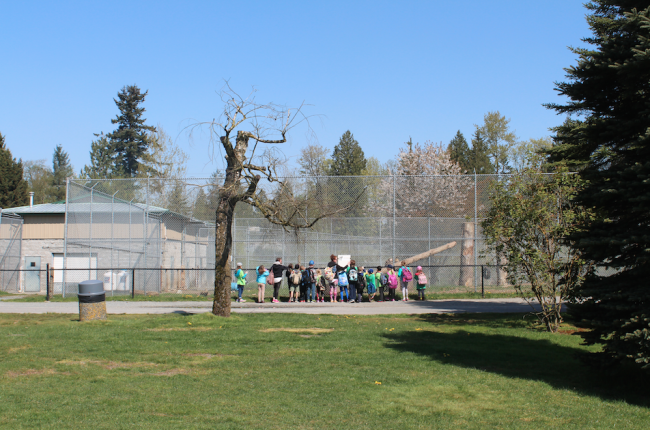
“I just don’t believe animals should be in captivity,” are extremely misguided words, according to the Greater Vancouver Zoo. About 60 protesters bombarded the zoo in Aldergrove on Easter Sunday, trying to convince guests not to enter. Chanting “Vancouver Zoo – shame on you,” the animal rights activists picketed the area calling for a boycott. This was the beginning of Jody Henderson’s day.
As zoo manager, she shows up to work knowing she is doing the right thing but aware that she is being portrayed by many as a wrongdoer.
“Why would we want an animal to die? It makes no sense to me,” she says. “We’re here because of our love of animals and to teach people about animals.”
The zoo is home to over 500 animals all at varying ages and stages of their lives. It’s true that at first glance it doesn’t necessarily “feel normal” to see these animals in enclosures so far from their natural habitat, until Henderson explains that for many, their natural habitat was with a human to begin with.
“A lot of these animals are either former pets or rescues, or raised in a captive environment,” she explains.
“That lion right there,” she says, pointing to the male resting in the shade, “is a former pet. “He escaped from his home when he was less than a year old and crossed the border into Quebec. In B.C. we have the strictest laws of exotic animals and I’m very proud of that, but it’s still legal to have a lion as a pet in Ontario.”

Zoo General Manager, Jody Henderson (Image: Nicolle Hodges)
Just like humans, no animal is going to live forever – there are illnesses and incidents, deaths and births. Henderson says it’s part of the whole system, and yet whenever something happens the public explodes with accusations and the media excavates the past.
“This place is the best place in the world when everything is going right, but the moment something happens, the whole mood changes,” she says.
Several years ago there was a break-in at the zoo and one of the spider monkeys was killed; he was thrown to the ground or against a tree and the intruders crushed his skull and then kidnapped his mate in the middle of the night.
“We put out an award for her safe return and I followed probably 150 leads in a period of six to eight months trying to find her…but we’ve never found her,” says Henderson. “Some people believe they would rather see an animal dead than in a captive environment.”
Immediately after the incident the zoo purchased more security and surveillance, which is only one of the many areas where they have heavily invested. They have a million-dollar hippo enclosure, doubled up on fences for safety, built an extensive cage system for their lemurs and on another occasion, built an entirely new enclosure all because of one snake.
“An international student had an albino burmese python; he phones us up several years ago and says he is moving on to campus at UBC and has no space for it, so he asks us to take it,” says Henderson.
The student then threatened to release the African snake into the B.C. wilderness if the zoo was unable to help.
“We spent about an hour and a half on the phone with him trying to explain that, ‘if you release it, it could eat up all the native species, hurt an animal or a small child and it probably wouldn’t survive,’” she says.
But he wouldn’t listen.
“So, we ended up taking it and building a new enclosure, all because we couldn’t stand his mindset and thinking about the damage he could do.”

Flamingos coexist with other animals at the zoo (Image: Nicolle Hodges)
Humans are consistently a factor for why many of the animals are at the zoo – something that Henderson agrees she has to do a better job explaining to the public.
For instance, in 2009 they opened a bald eagle enclosure for rescued eagles that were going to be euthanized because they could never fly again. Why? Because humans hit them with their trucks or cars on the highway.
They have spent thousands of dollars nursing tortoises back to health – reptiles that live over 100 years and grow to the size of wheelbarrows.
“People like them when they’re small and cute but then they don’t want them anymore when they get bigger,” says Henderson.
Zoos have evolved just like people’s attitudes have. Even as early as 15 years ago, they still used to be based around taking animals from the wild and training them to perform tricks for entertainment and ticket sales. With each new generation, slowly the sentiments towards these practices have changed and there has been more demand for the ethical treatment of animals. Henderson says the zoo has adapted, but “nobody knows that.”
Hence, the protests.
While humans remain the catalyst for change, they also remain the reason that many of the animals are captive to begin with. People are stomping their feet to have a foundation knocked down that they built with their own hands.
“We used to have elephants here, but we don’t anymore because we succumbed to the pressure from the public,” says Henderson. “Tina [the elephant] had been here for most of her life and we paid for her transportation to a wonderful sanctuary in Tennessee…eight months later she died; she never left the barn and she died of a heart attack.”
According to Henderson, the keepers at the zoo were her family and she should have never left.
“We say she died of a broken heart.”

Hippos in their enclosure (Image: Nicolle Hodges)
The recent protests are another example of misinformation dictating a situation. Henderson says the activist’s Facebook page was misleading by referring to animal cruelty charges against the zoo by the SPCA, without mentioning that the charges were stayed; which means the case couldn’t be proven and the Crown Counsel dropped the charges, therefore ending the prosecution.
The incident happened in 2006 when it was alleged that the zoo was keeping Hazina, a two-year-old hippo they acquired as a baby in 2004, alone in a windowless shed with a pool so shallow that she couldn’t float.
Henderson argues that it wasn’t a windowless shed but a temporary enclosure in a full sized barn with a small pool and windows, while a proper facility was being built.
“And despite their adaptations for life in the water, hippos can’t swim – they can’t even float,” she says. “Their bodies are far too dense to float, so they move around by pushing off from the bottom.”
Staff spend every day tending to and caring for the animals who have made the zoo their home – many who are rehabilitating from manmade injuries, others who have spent their lives being nurtured and are unable to return to the wild. While it may not seem “right,” it is the reality – one made largely because of human impact.
Henderson says the most important thing is that people get the facts straight. Although the zoo has been around since 1970, so much has changed over the span of those 45 years.
“Are we learning? Absolutely,” says Henderson. “But the only way we will get better is through funding and if people come here and support us. We’re privately run so we get no government money, it’s only through admissions, school tours and any one who wants to donate, that we can help these animals.”

Educational tours at the zoo (Image: Nicolle Hodges)
There is some good that comes from protests, Henderson admits.
“I believe animals should be taken care of but I think there is a huge misconception with how we’re doing it,” she says. “For me, if you really want to help, you come here to volunteer or you donate. I think people just don’t know enough. As you can see it’s a happy place…”
Henderson made notes on some of the false or skewed information mentioned by the protesters. She willingly provided them to Vancity Buzz for publication.
Zoo incident timeline and corrections
1995
- Not to my knowledge did we acquire animals from Stanley Park Zoo. Although if did, why would that be wrong? When a facility shuts down all zoos and aquariums come together to see if they can help with relocating animals rather than euthanizing them.
1999 to 2003
- Yes, we did take in three eurasian lynx that were from a lynx farm, and they all came in with severe medical conditions, including extremely poor body conditions, one of the lynx was blind and deaf, and all had very bad coats.
- Thousands of dollars were spent healing the animals and nursing them back to a good medical state. The male lynx from this group lived to the ripe approximate age of 19 years old. We humanely euthanized him after determining he had cancer in his nasal cavity in April 2014. Their median life expectancy is 15 years. So he lived at the Greater Vancouver Zoo for 14 years. The other female is still with us and is blind and deaf, and we love her dearly.
- Yes, we rescued a grizzly bear from the wild, she was approximately six months old and was left by a garbage dump in near Williams Lake.
2003 to 2004
- Zoocheck doesn’t support zoos and aquariums, so we definitely share a difference of opinions. We don’t report to Zoocheck and they don’t control us, we report to the Province of B.C., the Federal Government and to CAZA (Canada’s Accredited Zoos and Aquariums).
- In 2004 we did not lose our accreditation with CAZA, we simply did not reapply as we knew that from the previous inspection that we needed to build a proper indoor facility for the hippos and since it was not completed at that time there was no point in applying. Once the facility was completed we reapplied and received the accreditation.
2004
- Our female hippo, Gertrude, passed away of ovarian cancer and not a kidney defect at 22 years old. Median life expectancy of a hippopotamus is 36 years.
- Hazina, the young female hippopotamus, was acquired shortly after Gertrude passed as a new friend for Harvey. Hippos are not solitary animals and he had never been by himself, so we didn’t want him to be alone for very long. At the beginning we had to have them apart since she was significantly smaller than him and he would have hurt her.
- We were right in the middle of construction of the new building and the sounds of the construction would have stressed out a young hippo, therefore she stayed in a temporary enclosure for her safety. The construction lasted longer than we wanted it to, although we wanted to ensure that we had the proper facility built so that we wouldn’t have to come back in to make adjustments as time went along.
2005
- Telus did provide us with some funds after they filmed Hazina for their TV commercial. We both agreed that the money would go towards the new building that we were building for the hippos and it did.
2006
- The baby giraffe was born on June 21 and after much deliberation, it was decided we needed to intervene since it was clear the first time mom wouldn’t be able to deliver without assistance. After many hours of intensive care, and against all odds, the calf began to respond. Round the clock watch was set up to care and observe the baby… and for a couple of days she got stronger and then she levelled out. She was never able to nurse, so we had to bottle-feed her.
- The post mortem results indicated several rib fractures and pneumonia. We felt either she had a rib puncture her lung in the birthing canal or when she was first born her mom tried to get her to stand up and kicked her, but we feel most likely it was in the birthing canal.
2009
- We did take in two Cape buffalos that came from another zoo that lived very comfortable with zebras. When the buffalos were brought to our facility they were kept in the African Savannah barn where they could interact through noises and eventually nose to nose through the barrier fences. This interaction went on for several uneventful weeks, everyone was calm and there didn’t seem to be any problems. The Cape buffalos had a very even temperament, so when we released them to the rest of the savannah at the beginning it was all quiet until one zebra thought the buffalos were a threat and started to run. This started a chain reaction and the other zebras soon followed.
- Exertional myopathy is a muscle disease triggered when the muscles are exerted to a point that too much lactic acid is released into the body leading to a cascade of side effects. Unfortunately this condition is usually fatal and there is not much that can be done once it begins.
2011
- Our female giraffe, Eleah, passed at the age of 23 years.
2013
- Our rhino, Charlie, passed away at the approximate age of 46 years old. Charlie had been at the Greater Vancouver Zoo since 1998 and was our oldest ambassador at the zoo.
- Sweetie, our oldest Siberian tiger, was humanely euthanized after one month of constant vet care at the age of 18 years. She was in excellent body condition, 99 per cent healthy with no tumors, obstructions or infections, she had lots of body fat and her heart was normal.
- However, it was determined she had a hiatal hernia which was almost certainly present since birth and thus was congenital rather than traumatic in origin. Over time, the hernia likely stretched as it got more and more full. She did extremely well to live one year, let alone 18 years with no visual signs of the hernia. The median life expectancy of female tiger is 14 years.
2014
- Hani, one of our young Siberian Tigers, passed from an unclassified form of cardiomyopathy – a chronic and poorly understood genetic disease of the heart muscle – and it was this underlying problem which caused the buildup of fluid.
- Many domestic cats and some breeds of dogs suffer from similar forms of cardiomyopathy and it is almost always associated with sudden death. Sadly, there are no warning signs with this disease and no successful treatment protocols.
- It is important to realize that all animals, both wild and domestic, can have fatal genetic, congenital or acquired problems which we are powerless to treat.
Conservation efforts
The Greater Vancouver Zoo is involved in two local conservation programs:
- The Oregon Spotted Frog
- The Western Painted Turtle
They also support three programs in the wild:
- The Panthera (Iranian Cheetah Project)
- Arcas Wildlife Rescue & Conservation Association (Guatemalan Yellow-Naped Amazon Parrot)
- The Hornbill Nest Adoption Program (the Indian Hornbill)
Since they started supporting these programs in 2011 they have raised over $110,000 to help save these species.
They also participate in several Species Survival Plan (SSP) programs. Through strict population management and conservation efforts such as public education, research, reintroduction and field conservation programs they help assure a sustainable future for animals that are currently being threatened in the wild.
For more information on the Greater Vancouver Zoo, visit gvzoo.com.

(Image: Nicolle Hodges)

